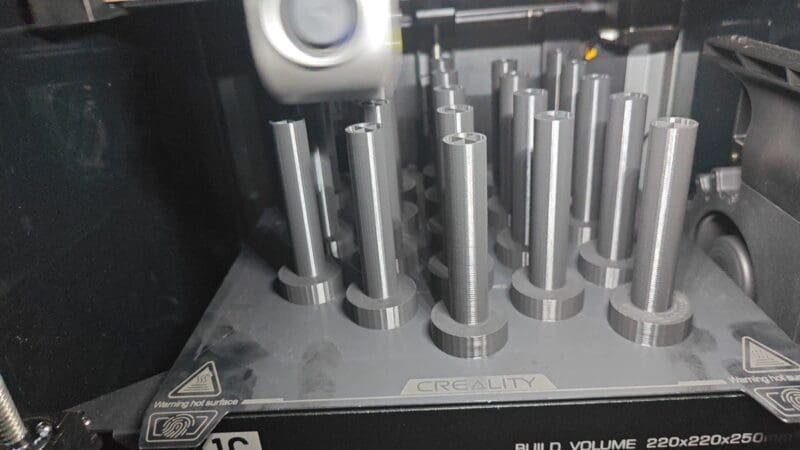How Long Does It Take to 3D Print?

With 3D printing, it’s easier and cheaper than ever to create, make prototypes, and make products. In the 1980s, Chuck Hull came up with the idea for 3D printing, which has grown from an idea to a famous technology. Most people who use 3D printing will want to know, “How long does it take to 3D print?” To answer this, you need to know what affects the time it takes to print with a 3D printer, figure out how long it takes, and understand what that time means.
What 3D printing means?
“Additive manufacturing,” which is what 3D printing is, lets things be built layer by layer from a computer 3D model. The method is used a lot in many different areas, like engineering, building, product design, and prototyping. It is popular because it is quick, inexpensive, and simple to use.
Why 3D printing time is important?
Time is one of the most important things to think about when 3D printing. Trying to figure out how long a 3D printing job will take is important. This helps people figure out how long the job will take and what tools they will need. It also helps figure out if the plan will work, find problems, and make the printing process better.
This post will talk about the most important things that affect 3D printing time, how to figure out that time, and what happens when you do that.

Factors that Affect the 3D Printing Time
The time it takes to print something with a 3D printer depends on a number of things, such as the size of the object, the speed of the printer, the layer height and thickness, the material used, how long it takes for each layer to cool, the complexity of the object, its pattern, and its finish.
2.1 The size of the thing
The longer it takes to print something, the bigger it is. For bigger things, you need more materials, more time for each layer, and more time for the item to cool. Large items can also cause problems with feeding, like clogging, skipping, or jamming.
2.2 Printer Speed
Most printers have settings that let users change how fast their printers print. But faster printing comes at the cost of lower quality, longer print times per layer, and more material waste.
2.3 Layer Depth and Height
How long it takes to print depends a lot on the height and thickness of the layers. Smaller layer heights and smaller layers make for better prints, but they take longer to print.
2.4 Materials Used
Melting and cooling times change from material to material, which affects how long 3D printing takes. Some things need a higher temperature to melt, so they take longer to cool. This makes it take longer to print. So, the material directly affects how long it takes to print.
2.5 Cooling in Layers
Before the next layer can be added, each layer needs enough time to cool. The whole time it takes to print will be longer if the cooling time is longer.
2.6 How hard the object is to make
The longer it takes to print something, the more complicated and thorough it is. Because the printer has to stop to make finer features, each layer takes longer.
2.7 Print Quality
Objects that need a better texture or finish will probably take longer to finish than ones that don’t. Depending on the materials used and how the design is set up, surface imperfections can add to or take away from the time it takes to print.
Figure out how long 3D printing will take
To figure out how long 3D printing will take, you need to think about a few things. These include the settings for the printer, the material used, the layer thickness, the complexity of the item, the speed of the print, and the cooling of the layers. There are three ways to figure out writing time:
3.1 Software that helps with math
Most 3D printing software has a built-in timer that figures out how long it will take to print by taking into account the things we’ve already talked about.
3.2 Manual Calculation
With this technique, you have to manually calculate the amount of time required for each layer while taking into account the printing speed and the height of each layer. Then, by adding up the times for all of the layers, one can determine the overall printing time.
3.3 Online Calculators
There are several online calculators that can figure out how long it will take to print something in 3D by taking into account things like the size of the item and how the printer is set up.
3.4 Things to Think about
Before figuring out how long something will take to print, you need to think about the speed of the printer, the type of material used, the height of the layers, how long it takes for each layer to cool, the size of the object, and how complicated it is.
What 3D Printing Time Means
The speed of printing is a balancing act. One can improve either in speed or quality. Both ways have good points and bad points.
4.1 The pros of printing quickly
When printing a lot of the same thing, it helps to have a fast printer. It is also helpful when making prototypes or equipment that doesn’t need much finishing. It also saves money because it takes less time to make the same number of items when printing quickly.
4.2 What’s wrong with fast printing
Fast printing lowers the quality of the finished product by making the texture and finish worse, simplifying the design, not giving it enough time to cool, and reducing the height and thickness of the layers. This could cause the item to pack, crack, or change shape.
4.3 Why it’s better to print slowly
When printing times are longer, the texture, finish, and patterns are better and more complicated. It also lets the layer height and thickness be bigger, which makes it less likely that the item will change shape.
4.4 What’s wrong with slow printing
Slow writing doesn’t always mean that the result will be better. Slower printing times use more materials, cost more, take longer, and are less practical when making a lot of the same thing.
4.5 Getting the right mix of Speed and Quality
For the best results, it’s best to find a good mix between speed and quality. When figuring out how long it will take to print, size, texture, and style should be taken into account. This will improve the output and make the end users happy.
You can speed up the 3D printing process in a number of ways:
- Reduce the layer height: Reducing the layer height can improve the quality of the print and cut down on the time it takes to print.
- Increase print speed: You can increase the print speed to cut down on the time it takes to print, but this may cause the print quality to go down. It is best to slowly increase the print speed until the quality is just right.
- Use a larger nozzle: A bigger nozzle can help you print faster while keeping the quality you want.
- Printing more than one thing at the same time can save you time because you can fit more things on the build plate.
- Use a faster slicing program: If you use a faster slicing program, it will take less time to process your 3D model.
- Optimize your 3D model: If you want to speed up the printing process, you can optimize your 3D model by getting rid of any extra features or by making the file size smaller.
- Invest in a higher-end printer. A higher-end printer can have faster print speeds and more advanced features that can help speed up the 3D printing process.
5. Conclusion
In conclusion, 3D printing is a fast, flexible, and inexpensive way to make things that are becoming more famous in many fields. But printing time is a very important part of the planning process, and there are many things that affect it. Understanding these factors, how the 3D printing time is calculated, and what it means, and finding a good balance between speed and quality, leads to great finished goods.
6. FAQ
How long does it take to make a small item using 3D printing?
Depending on how hard the design is and how fast the printer is, it can take anywhere from 30 minutes to a few hours to 3D print a small item.
How long does it take to 3D print an item that medium-sized?
Depending on how complicated it is and how fast it prints, it can take anywhere from a few hours to a day or more to 3D print a medium-sized item.
How long does it take to make a big thing on a 3D printer?
Depending on the size and complexity of the item, it can take several days to a week or more to 3D print something big.
How does the setting for layer height affect the time it takes to print?
Lower layer heights make for better print quality, but they take longer to print. Prints with more layers look worse, but they take less time to make overall.
How does the amount of infill affect the time it takes to print?
A higher infill percentage means that there will be more material on the inside of the printed item, which makes it take longer to print. Printing goes faster with lower filling percentages, but less material is used.
Does the kind of 3D printer change how long it takes to print?
Yes, it does. Different kinds of 3D printers have different speeds, abilities, and choices, all of which affect how long it takes to print.
How long does it take to make a complicated shape on a 3D printer?
It can take a lot longer to print complex shapes than it does to print simple shapes. This is because complex shapes need more material and more accurate printing to get the desired result.
Does the color of the thread change how long it takes to print?
No, the color of the material doesn’t change how long it takes to print. But printing temperatures can be different for each color, which can change the whole printing process.
How long does it take to make a toy with a 3D printer?
It varies on how big and complicated the toy is, but most toys take a few hours to print.
How long does it take to 3D print a prototype or a big commercial part?
Depending on the size and complexity of the part, it can take several days to weeks to 3D print a big commercial part or a prototype. When making these kinds of parts, there may be more than one round of changes and testing.
DISCLOSURE: THIS POST MAY CONTAIN AFFILIATE LINKS, MEANING I GET A COMMISSION IF you DECIDE TO MAKE A PURCHASE THROUGH MY LINKS, AT NO COST TO YOU. PLEASE READ MY DISCLOSURE FOR MORE INFO.



